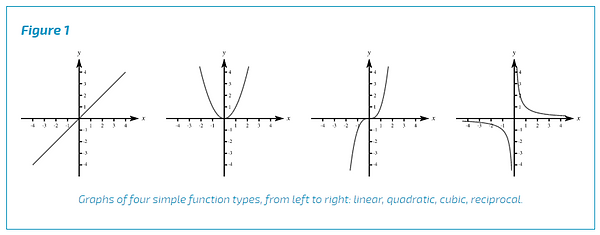<A>
functions (of a system of forces):*
the mathematical concept of function is used in physics to represent different physical quantities. Function to represent a charge distribution (or even electric field strength) in space and time. In gravitation it is used to represent a mass distribution (and momentum distribution) in space and time. Some simple function types are linear, quadratic, cubic and reciprocal functions. In their simplest forms, these functions are:
Linear (𝑥) =𝑥
Quadratic (𝑥) =𝑥2
Cubic ℎ(𝑥) =𝑥3
Reciprocal (𝑥) =1𝑥
Graphs of these functions are shown below (Figure 1):

<B>
parallelism: *
Wundt (influenced by Leibniz) introduced the term psychophysical parallelism:
"… wherever there are regular relationships between mental and physical phenomena the two are neither identical nor convertible into one another because they are per se incomparable; but they are associated with one another in the way that certain mental processes regularly correspond to certain physical processes or, figuratively expressed, run 'parallel to one another'."
extract from his Floor Plan of Psychology, 1902–1903
<C>
electro-dynamics: *
A branch of physiology that studies the nervous system is neurophysiology. The primary tools of basic neurophysiological research include electrophysiological recordings (patch clamp, voltage clamp, extracellular single-unit recording and recording of local field potentials). An early contributor was Hermann von Helmholtz who in 1849, studied the speed of frog nerve impulses while studying electricity in the body. Wundt joined Heidelberg University as an assistant to Helmholtz in 1858. During his Heidelberg years from 1853 to 1873, Wundt published numerous essays on physiology, particularly on experimental neurophysiology, a textbook on human physiology (1865) & a manual of medical physics.
<D>
thought-functions: *
An example of this law – the perceived loudness/brightness is proportional to logarithm of the actual intensity measured with an accurate nonhuman instrument.

The relationship between stimulus and perception is logarithmic. This logarithmic relationship means that if a stimulus varies as a geometric progression (multiplied by a fixed factor), the corresponding perception is altered in an arithmetic progression (in additive constant amounts).